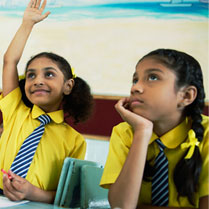You may or may not have heard that we are getting hammered with the  snowstorm in the Northeast today. My son’s school, Georgetown University in Washington, DC, has been closed since Saturday; unheard of! Anyway, all these blizzard conditions have allowed me to reflect back on various snow days in my children’s school life. While snow days are a child’s best friend, it can be a real hassle for the parents; either the working mother who needs to find alternative child care options or the stay-at-home mom who has to figure out how to keep the kids busy. My personal experience with snow days also brings back memories that at this point, I can only laugh about it, while at the time it was definitely not funny.
snowstorm in the Northeast today. My son’s school, Georgetown University in Washington, DC, has been closed since Saturday; unheard of! Anyway, all these blizzard conditions have allowed me to reflect back on various snow days in my children’s school life. While snow days are a child’s best friend, it can be a real hassle for the parents; either the working mother who needs to find alternative child care options or the stay-at-home mom who has to figure out how to keep the kids busy. My personal experience with snow days also brings back memories that at this point, I can only laugh about it, while at the time it was definitely not funny.
Before schools had great websites and mothers were comfortable with the internet, the way we were notified that school was closed was through what was called the “phone chains”. The superintendent or head of the school would decide very early in the morning whether or not it was necessary to close school for the day. They would make a call to the first mother, which was would then start a phone chain where all the families would get notified by a phone call. As a head class mother, I would get one of the first calls which was very early in the morning. It was always interesting to get that call at 5:30 am to be told that you can sleep extra late because no one has to get up to get the school. Anyway, I remember getting that call one year at maybe 5:45 in the morning. I was still very asleep, but I had my list of mothers that I had to call right next to the phone. So I made those calls and went back to sleep. The problem was that I had children at two different schools, and I had called the wrong list of parents.
So I had mothers who were trying to get their kids to a school that had been closed and then I had a whole group of kids that never showed up for school that day. I realized my major mistake when I got the call from the school about where was my son and I realized what I had done. I had to apologize to all the mothers who fought to get their kids to a school that was closed (because they never got “the” call) and then had to call the other mothers at the other school and tell them that they had to hurry and get their kids to school. Needless to say, I was not made a class mother the next year and I love the school website that now posts these types of announcements and has allowed schools to get rid of the phone chains.
Another time, the kids had gone to school and the snow started to really come down. So all of the parents were notified that school was closing early and we had to come get the kids at school. I was already out and volunteered to get a group of the neighborhood kids. I rounded up the first girl who was the oldest of the group. She was very quiet and easy to attend with. I then got the other kids who were younger and much harder to get moving in the right direction. As the snow was really coming down at this point, I was concentrating on getting everybody to the van safely. It’s that time when you think a sheep dog would really be a big help in rounding them in the right direction.
Anyway, I cleaned off the car as best as I could and yelled at all the kids to put on their seat belts, be quiet and let’s get home. As I turned down the street to take the oldest girl home, (the one who was the first one I had gotten from the principal’ office, the one who was very quiet, but always very cooperative), one of the other kids in the car said, “Why are we going this way?” And I said, “I am taking Nicole home first”. At that point, they pointed out to me that Nicole who always sat in the seat behind the driver’s seat was not in the car. In all the commotion of getting the others to the car, I had left her at school. Needless to say her mother said, “Don’t worry. I think I’ll take it from here.”
Anyway let us know your snow day stories. Also, what is the equivalent of a snow day for kids who go to school in a warm climate? Have fun, stay warm and be safe!



 Posted by findingschools
Posted by findingschools  Mom and Dad attended the parent-teacher meetings at an English-medium, independent school in India. They spoke briefly to each teacher: the “maths” teacher, the science teacher, the Hindi teacher and finally the English teacher. The English teacher said, “You’re daughter is lovely, but her accent is so thick that no one understands her. Also, she speaks too fast.” Well, Dad was perplexed, “Accent? What accent?”
Mom and Dad attended the parent-teacher meetings at an English-medium, independent school in India. They spoke briefly to each teacher: the “maths” teacher, the science teacher, the Hindi teacher and finally the English teacher. The English teacher said, “You’re daughter is lovely, but her accent is so thick that no one understands her. Also, she speaks too fast.” Well, Dad was perplexed, “Accent? What accent?”
Report Cards from Around the World: Sydney, Australia
October 23, 2009~ Hold on to your hats! ~
~ Fourth Stop ~ Sydney ~
.
.
Student Report Basics
Here’s the report card! The blue numbers highlight a few interesting aspects of the report and the numbers correspond to notes below the image.
1. Descriptions, Definitions and Instructions
Unlike any other report card we have seen so far, this evaluation is 11 pages long (for instance, the report cards from Dalhousie and Kathmandu are two pages and consist primarily of numbers, rather than words). While many other educational systems attempt to summarize a year’s worth of work into a page or two, this report card include descriptions of the child’s performance, definitions of expected “outcomes” and provides the parents with instructions for interpreting the report card. (Note that this is the first Elementary School report card we have analyzed). Parents, grab a cup of coffee and find a comfy seat, this might take a while!
2. Key Learning Areas determined by the New South Wales Board of Studies
Australians base the educational system and curriculum on Key Learning Areas, which consist of English; mathematics; science and technology; the arts; health and physical education; and study of human society and its environment, which includes languages other than English. The Key Learning Areas and “outcomes and guidelines for indicators” demonstrate the government’s involvement in upholding a certain standard of education.
3. Children are Different
“Children can have different learning needs and may be working towards outcomes at an earlier or later stage.” Translation ~ parents, don’t worry if you’re child is ahead in some areas and behind in others!
.
4. Progress on a Scale!
These scales show this student’s progress for the areas of English and Mathematics. This student has reached the targeted outcomes for Grade 2 (which is the second year of Stage 1), and is ready to begin Grade 3. This visual representation of progress is a relatively unique aspect to report cards!
.
5. English and Mathematics… whole numbers, volume, time, chance…
About 5 pages are dedicated to English and Mathematics and each area is broken down to the subsections listed below.
English
Mathematics
6. Your child is Competent… Developing… Needs Support…
Each area listed above includes a list of “indicators.” The teacher then marks the child’s achievement for each indicator as competent, developing or needs support. Note that these categories are stated in the positive form of the meaning (rather than, “is behind the rest of the class”). For instance, in writing, this child:
Consider how this differs from JUST a letter or number grade for mathematics in general; in comparison to all the information provided, the letter or number illustrates only the child’s standing in relation to the other students in the class. This process explains the child’s progress in relation to each task.
.
7. Social Development… at a 2nd grade level
Besides English and mathematics, students receive an assessment for Religious Education, Science and Technology, Human Society and Its Environment, Creative Arts (Music, Visual Arts, Drama) and Health and Physical Education. Teachers also assess Social Development and Work Habits. Looks like this student is “developing well” in some areas and is “highly developed” in others. Well done!
.
8. General Comments
This section allows the teacher to comment on the child’s social and academic development, noting areas that may need attention.
.
See Report Card from Dalhousie, India; Kathmandu, Nepal; Soro, Denmark
Report card analysis to look forward to: Palestine, Malawi, Australia, Canada, Mexico and more!